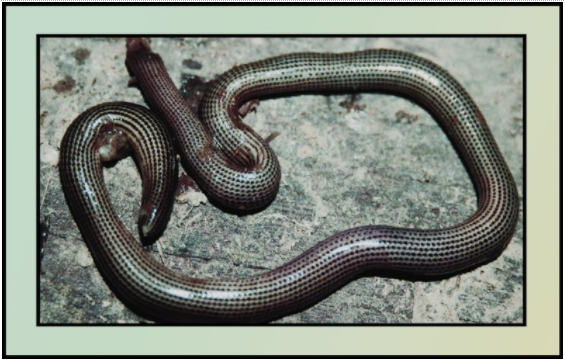
Typhlops is a
(a)True snake
(b)False snake
(c)True worm
(d)Shark
Answer
574.2k+ views
Hint: These were the first class of organisms to adapt to life on land. They are believed to have evolved from the amphibians millions of years ago. They are elongated, legless, carnivorous reptiles. They belong to the phylum Reptilia.
Complete answer:
Typhlops is a genus of blind snake found in Europe, Africa and Central and South America but there is an exception for New Zealand. It looks like an earthworm and it is a small burrowing non-poisonous snake. It is a true snake.
Additional Information: Few Characteristics of Reptilians are the following:
-They are cold-blooded animals found in most of the hotter regions of the planet.
-Their skin is dry, and rough, with no glands.
-The body is split into head, neck, trunk, and tail.
-Few of those shed the scales on their skin as skin cast.
-The respiration takes place with the help of the lungs.
-They are oviparous and therefore the eggs are very yolky.
-The nervous system comprises 12 pairs of cranial nerves.
-The lateral line organ system is absent in reptiles.
Examples include Snakes, Turtles, Lizards, Crocodiles etc.

So, the correct answer is, “True snakes.”
Note: Because some reptiles are more closely related to birds than they are to other reptiles as they share common characters with the birds. The reptiles and the aves belong to the vertebrates. Archaeopteryx forms a connecting link between reptiles and birds as it possesses characteristics of both birds and reptiles in common.
Many extinct species had biological characteristics of two or more biological species during evolution. Such types of species are connecting links.
Similarly, Seymouria is also an extinct species which also has a role as a connecting link between amphibians and reptiles. As Seymouria's head structure was similar to amphibians but the body structure was similar to reptiles and so it has both the characters of amphibians and reptiles.
Complete answer:
Typhlops is a genus of blind snake found in Europe, Africa and Central and South America but there is an exception for New Zealand. It looks like an earthworm and it is a small burrowing non-poisonous snake. It is a true snake.
Additional Information: Few Characteristics of Reptilians are the following:
-They are cold-blooded animals found in most of the hotter regions of the planet.
-Their skin is dry, and rough, with no glands.
-The body is split into head, neck, trunk, and tail.
-Few of those shed the scales on their skin as skin cast.
-The respiration takes place with the help of the lungs.
-They are oviparous and therefore the eggs are very yolky.
-The nervous system comprises 12 pairs of cranial nerves.
-The lateral line organ system is absent in reptiles.
Examples include Snakes, Turtles, Lizards, Crocodiles etc.

So, the correct answer is, “True snakes.”
Note: Because some reptiles are more closely related to birds than they are to other reptiles as they share common characters with the birds. The reptiles and the aves belong to the vertebrates. Archaeopteryx forms a connecting link between reptiles and birds as it possesses characteristics of both birds and reptiles in common.
Many extinct species had biological characteristics of two or more biological species during evolution. Such types of species are connecting links.
Similarly, Seymouria is also an extinct species which also has a role as a connecting link between amphibians and reptiles. As Seymouria's head structure was similar to amphibians but the body structure was similar to reptiles and so it has both the characters of amphibians and reptiles.
Recently Updated Pages
Master Class 12 Business Studies: Engaging Questions & Answers for Success

Master Class 12 Economics: Engaging Questions & Answers for Success

Master Class 12 English: Engaging Questions & Answers for Success

Master Class 12 Maths: Engaging Questions & Answers for Success

Master Class 12 Social Science: Engaging Questions & Answers for Success

Master Class 12 Chemistry: Engaging Questions & Answers for Success

Trending doubts
What is meant by exothermic and endothermic reactions class 11 chemistry CBSE

Which animal has three hearts class 11 biology CBSE

10 examples of friction in our daily life

One Metric ton is equal to kg A 10000 B 1000 C 100 class 11 physics CBSE

1 Quintal is equal to a 110 kg b 10 kg c 100kg d 1000 class 11 physics CBSE

Difference Between Prokaryotic Cells and Eukaryotic Cells




